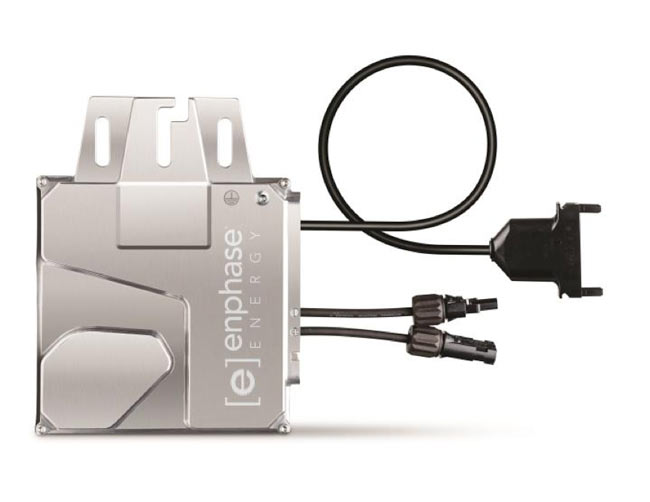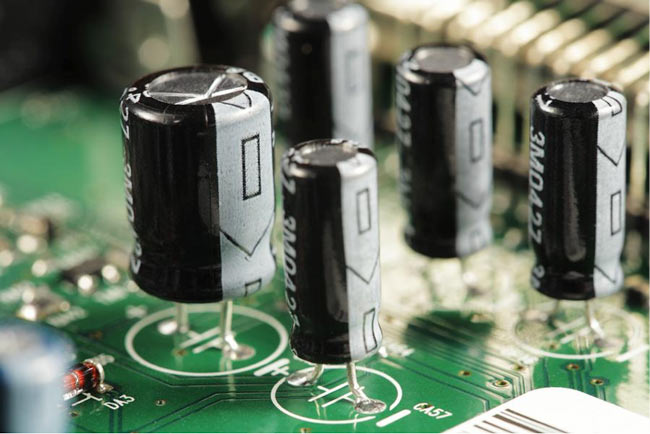Part 1 of an interview with Enphase VP of Quality & Reliability: Ciaran Fox
In my experience solar installers either really love microinverters, or are incredibly wary of them. There seems to be very little middle ground.
Those who love them talk about their ease of installation, increased power output, flexibility of panel layout, panel level monitoring and shade performance.
Those who are wary of them generally worry about their reliability.
A microinverter is a box of sophisticated electronics that sits on your roof (under each solar panel). In Australia your roof gets hot! And if a microinverter fails, replacing it means climbing on the roof and removing the panel. So installers’ concerns are understandable.

A microinverter. You generally use one per solar panel instead of a single large central inverter. They are about as big as an iPad mini
To get some authoritative answers, I asked installers that I know to send me their toughest questions about microinverter reliability.
I then put those questions to Ciaran Fox who is the Vice President of Quality & Reliability at the world’s biggest microinverter manufacturer, Enphase.
The installers had one concern above all others. They believed that electronics with electrolytic capacitors are inherently unreliable at high temperatures.
Microinverters generally contain multiple electrolytic capacitors.
Electrolytic capacitors are small electronic components that have a reputation for being fragile. They look like this:

Electrolytic Capacitors on a circuit board
Here’s what Ciaran had to say about the issue:
Finn: A microinverter contains a lot of electronics including electrolytic capacitors and sit on a hot roof. Doesn’t this logically mean that they will be less reliable than a central inverter?
Ciaran: Let me start with electrolytic capacitors. We are confident in the reliability of electrolytic capacitors based on the design, the testing, our supplier relationships and our precise knowledge of the field usage conditions. In terms of design, one of the things we do is we minimize the stress on all components, but specifically the electrolytic capacitors. There are very specific de-rating requirements we have – otherwise the product doesn’t ship.
And that builds in a significant margin in terms of safe and reliable usage.
Secondly – let’s say for the sake of discussion that there was a failure of an electrolytic capacitor in an Enphase microinverter (there won’t be! But let’s imagine there was). There is a built in redundancy such that the component failure would not fail the unit. And that’s part of our design process. We design to a very high MPPT efficiency, and to get that efficiency, you need that redundancy.
And then there’s the product development process itself. We extensively test at the component level, and these environmental stress tests can run more than a year. Then we do the unit level testing. Between the two tests, we literally test thousands of units under high environmental stress conditions (extreme humidity and temperature etc.) before the product is launched.
To date we have not seen an electrolytic capacitor fail in those tests.
This may sound a little strange to you, but when we use electrolytic capacitors in the design we can get a higher efficiency, which means you get less temperature stress on all the other components. So the net reliability of an Enphase microinverter with electrolytic capacitors is higher than if we used an alternative component.
And our field data reflects that. We’ve now shipped millions and millions of units containing multiple electrolytic capacitors (approximately 9 million units and 36 million capacitors). And the number of electrolytic capacitors that have failed in the field are less than my number of fingers. The electrolytic capacitors we deploy are extremely reliable and we are very proud of that.
Note from Finn: we were speaking on the phone so I couldn’t confirm how many fingers Ciaran had, however I have now got firm photographic proof that Ciaran has a full complement of 10 fingers. So less than 10 capacitor failures from 9 million micro inverter shipments.

Ciaran Fox, VP of Quality & Reliability at Enphase.
Finn: Where do you think this myth that electrolytic capacitors are incompatible with reliable power electronics comes from?
Ciaran: It is a very common myth and it actually goes back to some early experiences with PCs. Their problems were driven by some variations in the supplier’s quality control, which had a poisoning effect on the component quality. That together with how the capacitors were being stressed in the finished PC created this issue of lots of failures. I think this all happened more than 10 years ago. This caused a significant issue in the PC industry and the electrolytic capacitor’s reputation was seriously hurt.
Electrolytic capacitors are used in many different products, including airbags. These things have to be reliable! But you have to choose your suppliers very carefully. Our suppliers are the best in the world in my opinion, and if you were ever to visit their factories, you’d see they were state of the art.
To get a reliable microinverter you need to know the stresses that the units are getting out in the field. Because our microinverters communicate their performance back to us by default through the Enlighten platform, we know the stresses placed on millions of microinverters around the world. In particular we have a very precise understanding of the temperatures they are subject to.
This understanding feeds back into our product design cycle to improve the reliability with every new generation of microinverter. For example the reliability of our 4th generation microinverter (Enphase M250) is currently 6 times better than our third generation microinverter (Enphase M215) which was a very reliable product to start with.
My thoughts:
So there you have it. Less than 10 capacitor failures from 36 million capacitors on hot roofs. Electrolytic capacitors can very well be part of an inverter that operates reliably at high temperatures. Yes, low quality capacitors in badly designed circuits will fail, and God knows we have no shortage of el cheapo inverters in Australia where this happens regularly. But a high quality electrolytic capacitor in a well-designed circuit will not be the weakest link in an inverter, even at high temperatures.
So – if you are considering microinverters here are two takeaways:
- Get the latest generation inverter, as the reliability is increasing substantially with each iteration
- Buy a good quality microinverter. In my opinion your only choice here is Enphase, SMA or SolarBridge. Unfortunately since SolarBridge was bought out by Sunpower, SolarBridge micros are not for sale any more, unless you want it on a Sunpower panel.
Next time I’ll post Part 2 of our interview where I lob this curvy one at Ciaran:
“If you use microinverters for a 5kW system, you have 20 separate inverters. Doesn’t this mean that to be as reliable as a central inverter system, the microinverters have to be 20x more reliable than a central inverter?”

 RSS - Posts
RSS - Posts



If electrolytic capacitors are so much improved in quality why no one is suggesting using a banks of electrolytic capacitirs as relacement for batteries?
I think it will workout cheaper and have longer life than batteries and zero maintanance
Hi Girishkumar,
The Ultrabattery developed by CSIRO uses lead acid batteries with capacitors to create a high performance, cheap(ish), long lasting battery. The capacitor allows for high power drains without trashing the cells:
http://www.ecoult.com
Finn
“Buy a good quality microinverter. In my opinion your only choice here is Enphase or SolarBridge.”
Wouldn’t SMA microinverter also be in the good quality pile? or are their microinverters not as good as their string (macro?) inverters?
yes – good point – I’ll update the article to include SMAs.
I didn’t see any numbers on temperature range, very important to know in Australia. In Perth during summer we always get a week or two with temps over 40deg in the shade. The further North one goes the longer and higher the variations go.
Hi Paul,
The failure numbers include all micros installed worldwide – including Australia, and other crazy-hot places like New Mexico.
I’ll be posting about high temperatures and micro inverters soon.
Cheers,
Finn
I am one of the people that do not trust microinverters that are installed directly to solar panels.
I used to repair Televisions as an occupation at one stage and the bulk of the faults were either directly or indirectly caused by electrolytic capacitors. Electrolytic capacitors come in 2 heat ratings 85 and 105 degree Celsius. Most reputable brands used the 105 deg ones and failures were rarer but still happen.
Electrolytic capacitors have a dielectric in them that dries out with time and heat speeds up this process. The more it dries out the less the capacitor acts as a capacitor and its capacitance value also reduces. Televisions that placed electrolytic capacitors near heat sinks which dissipate heat, caused those capacitors to fail much more quickly than others in the television.
I do not believe microinverters have been around long enough for this drying out process to happen yet, hence very few failures at this point. I would like to see how many start to fail in a few more years. Only then would I consider changing my views on microinverters being installed directly to solar panels where heat is obviously an issue.
I have another question about micro inverters.
I have read quite a bit on forums regarding television signal interference by the inverters.In some cases people have said that they cannot get certain television channels ,the main one being the ABC.
Is there any truth in this ?
I don’t know of any issues with good micro inverters and RFI – they meet the same emissions standards as other consumer electronics.
The notorious PC power supply electrolytic capacitor failures were largely due to failing to use Low-ESR electrolytics in the switch-mode DC-DC converter. A SMPS pulls high pulse currents at a high frequency, leading to high I-squared-R losses in ordinary-grade electrolytics. The increased power dissipation cooks the wet capacitor, even to the point of rupture.
When I designed electronic equipment for use in Australia’s telecommunications network, we used only high reliability electrolytics, specifically rated for high temperature, and then only exposed them to half their rated working voltage. (Our gear had to work for 25 years.)
However, please google the “Arrhenius equation”, which reminds us that
every 10°C rise in temperature halves the lifetime of an electronic component.
Also, please check the reliability data for e.g. a 105 deg C electrolytic. It’s only good for maybe ten thousand hours at that temperature, if you’re lucky.
The equation also applies to the semiconductors put up on a roof to cook.
I think that it is pushing your luck, at least in our climate. Let’s see the failure rate in ten years.
errr….at $1400.00 extra on a 5KW system that’s going to add another 2 or 3 years to the payback period which on a 5KW at present prices would be between 6 and 10 years add another 2 or 3 that’s getting around 12 so you put the system in at the age of 65 you will probably be dead before you get a benefit and I have to ask how much extra power will that allow me to collect?
because basically unless I am pulling 5KW every hour I am feeding back to the grid.
The highest quality electrolytic capacitor manufactures use charts that start at 105 deg C and display the lifetime increasing by a factor of 2 for every 10°C drop in temperature (Arrhenius equation). There is no reason for the capacitors that Enphase uses in their microinverters to have a lifetime of less than 25 years.
If electrolytic capacitors are not to blame (the interview seems to suggest they are not), what is causing all of the M190 failures? At this point, Enphase has started a program to either replace them, or modify the firmware to lower the maximum output power.
Assuming the temperature and ripple current permit long life, the upper limit of aluminum electrolytics beyond 15 years is affected more by the integrity of the rubber seal, which can oxidize and crumble depending upon atmospheric conditions.